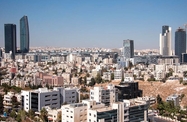The crisis in Syria is weighing heavily on the Jordanian economy. While the cost of supporting some 500,000 registered refugees is perhaps the most obvious challenge for a government with serious budget constraints, the impact of events across the border extends to multiple areas of the economy, from an increase in food prices to trade route disruptions.
According to a July article in medical journal The Lancet, co-authored by the Jordanian minister of health and environment, the government spent an estimated $53m on medical care for refugees between January and April, with only $5m provided in direct support by UN agencies during this period. The government will have to boost its total annual health expenditure by $135m in 2013 to provide the same level of care to the new refugees projected to arrive by the end of the year. It estimates that an additional $180m will be needed to expand and upgrade 10 existing facilities in the northern governorates to cope with the massive demands on the health care system there.
In addition to the direct financial strain the refugee influx has put on public finances, Jordanian citizens are coping with myriad direct and indirect economic consequences of the violence across the border.
The agricultural sector – which accounts for about 4% of Jordan’s GDP – has been among the affected areas. Some 60% of Syrian refugees are located in small towns or villages in the governorates of Irbid, Mafraq, Balqa and Ajloun, where farming is one of the main livelihoods, according to the Food and Agriculture Organisation (FAO). Border communities in Jordan that had benefitted from government-subsidised seeds, fertilisers, pesticides and animal feed from Syria, or earned income by trading or smuggling Syrian agricultural inputs through informal trade networks, have seen the costs of production rise significantly.
Shortages in inexpensive poultry products imported from Syria, the increased price of animal feed on the local market and a spike in animal-borne diseases due to strained border controls have caused the price of eggs to increase four-fold, according to the FAO. Animal feed prices rose by 22-38% between 2009 and 2012, mostly due to increased transportation costs as a result of the change in the trading route from Tartous in Syria to the new ports of Aqaba and Haifa. Meanwhile, the illegal cross-border trade in Syrian livestock has pushed the price of sheep and goats down by half in some areas of the country. Competition between Syrian refugees and Jordanians in rural areas has depressed seasonal farm wages as low as JD150 ($210) for 30 days of work.
Agricultural commodities that once travelled overland through Syria to markets in the Arabian Peninsula and Iraq, or were trans-shipped through the port of Latakia to Eastern European countries are now transported by sea through ports in Israel, Turkey or Egypt, or by air from Lebanon, at a much higher cost to producers. Some farmers in the Jordan Valley have resorted to throwing away large amounts of vegetable produce due to be exported because transport costs have skyrocketed, the Jordan Exporters and Producers Association for Fruit and Vegetables has reported.
Concerns of an impending crisis in Jordan’s food supply are also mounting as the government copes with a rising import bill due to increased demand from refugees and a decline in Syrian food imports of at least 50%. In the spring, the FAO estimated that the government's six-month supply of strategic food reserves would be depleted within four months if the number of refugees continued to grow at the existing rate, and also questioned the government’s ability to maintain its food subsidy programme, which costs the equivalent of 1% of GDP annually. Between 2011 and 2012, overall food prices increased by 5% in Jordan. The Jordan Food and Drug Administration reported that the kingdom imported 87% of its food requirements in 2012, at a total annual cost of JD2.2bn ($3.1bn), which represents 14% of its total import bill.
The Syrian impact on Jordan’s economy has not been all bad. The unemployment rate has dropped from 12.9% to 12.2% this year, according to a report by the UN Economic and Social Commission for Western Asia, despite the increasingly widespread perception among Jordanians that Syrians are taking their jobs. In 2012 Syrians injected more than $1bn of capital into the Jordanian economy, which is expected to grow by just 3% in 2013, according to the most optimistic forecasts.
In the wake of the government’s decision in July to remove a fuel subsidy of around 2.4% and double mobile telephone tax rates, tensions between Syrians and their Jordanian hosts appear to be mounting as the country determines how to respond to the largest potential refugee influx yet in the autumn. According to a poll conducted by the University of Jordan’s Centre for Strategic Studies in April, 71% of the national sample and 43% of the opinion leaders surveyed by researchers did not believe that Jordan should allow any more Syrian refugees to enter.
The government agreed to implement a major austerity programme when it took a $2bn loan from the IMF to give it time to deal with a gaping $2.8bn budget deficit, so more subsidy cuts are forecast. Any further reductions in government assistance are expected to worsen disparities between low-income Jordanians and the growing population of Syrian refugees who receive direct assistance from aid agencies and enjoy many of the same government services as citizens of the kingdom.


